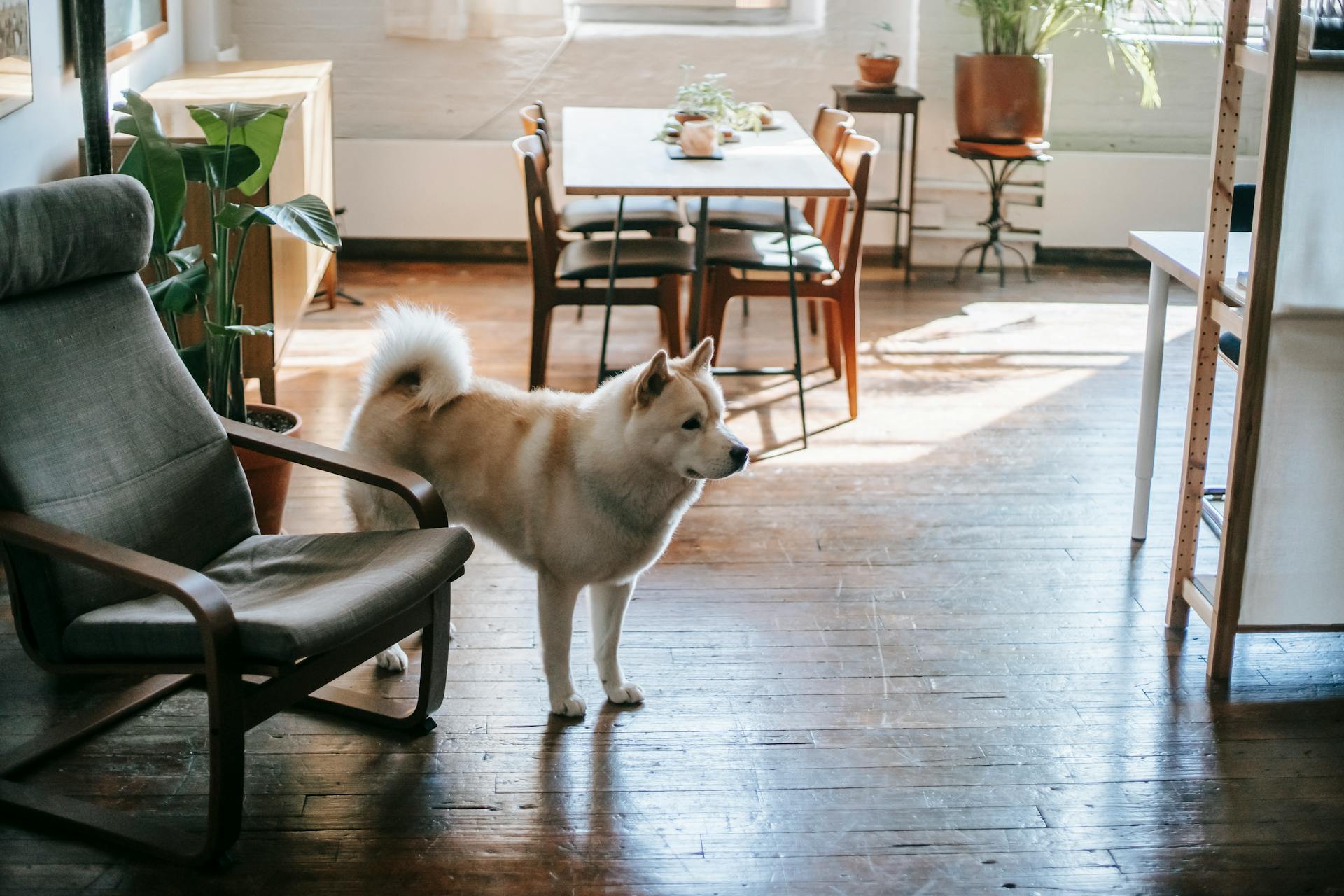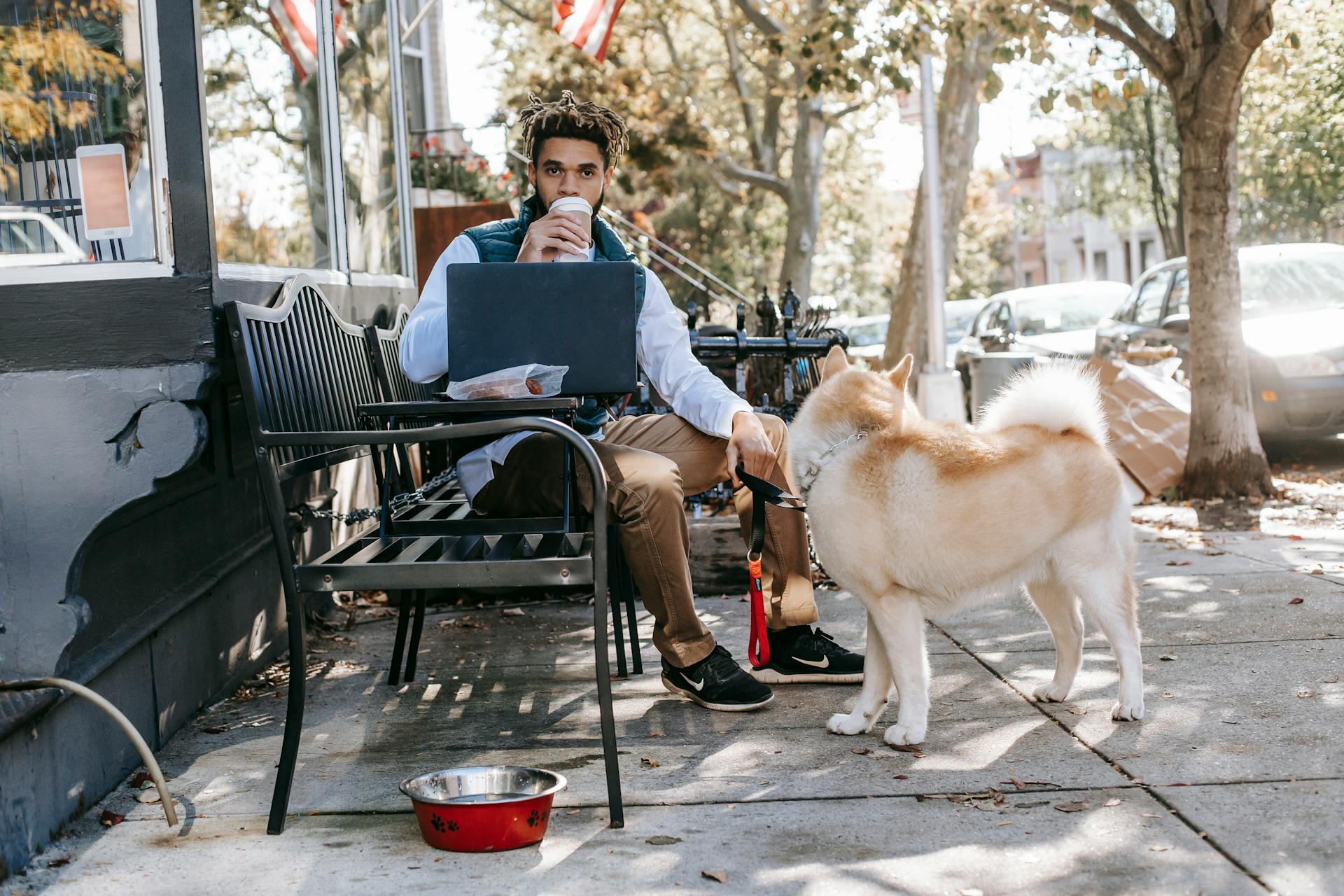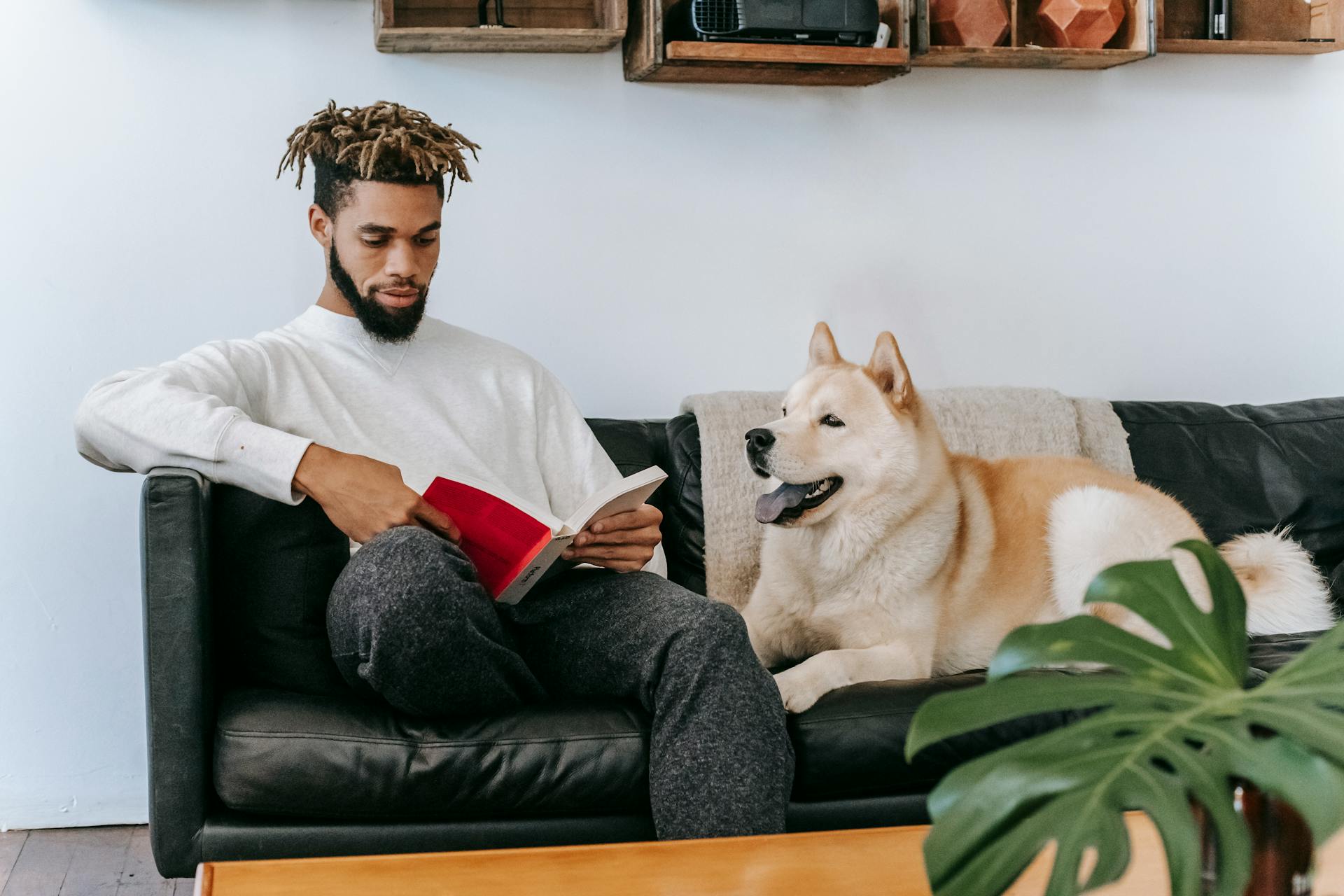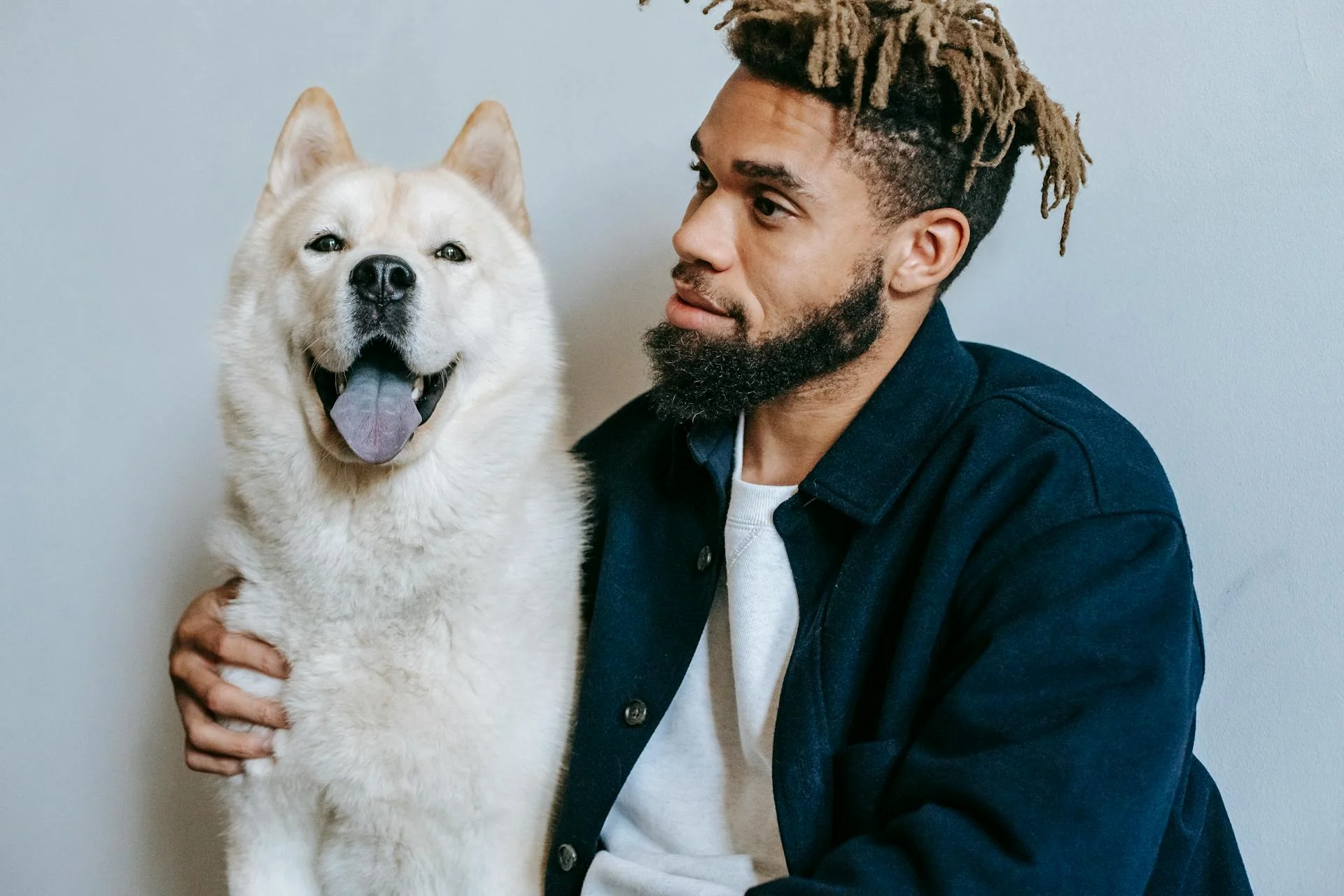
The American Akita is a large and powerful breed that originated in Japan and was later developed in the United States. They are known for their distinctive appearance and loyal temperament.
One of the most notable characteristics of the American Akita is its size, with adults typically weighing between 70-130 pounds and standing between 24-28 inches tall. Their thick double coat requires regular grooming to prevent matting and tangling.
Despite their intimidating size, American Akitas are gentle and affectionate companions, often described as "sweet" and "laid-back." They are naturally wary of strangers and may require time to warm up to new people.
Discover more: American Akita Size
Characteristics
The American Akita is a big-boned breed, much larger than the Japanese Akita, the Akita Inu. They have a sturdy stance and are a powerful Spitz breed.
Their skin is pliant but not loose, and their undercoat is dense and delicate. Their outer coat is straight, rough, and coarse, with a slight increase in length along their lower neck, belly, and hindquarters.
Their muzzle is slightly tapered, with a coal-black nose, thick jawline, and thin black lips. Their small, dark brown eyes are striking and almond-shaped.
Size and Weight
The American Akita is a sturdy breed with a robust build, and its size is one of its most distinctive features.
On average, adult females weigh between 70 to 100 pounds and reach a height of 24 to 26 inches.
Males, on the other hand, typically weigh between 100 to 130 pounds and measure anywhere from 26 to 28 inches at the shoulder.
Here's a breakdown of the average size and weight of American Akitas:
In comparison to the Japanese Akita, the American Akita is generally larger.
Coat Colors
The Japanese Akitas have a distinctive coat color palette, with red, white, and brindle being the dominant colors.
These colors are often paired with white markings, known as "urajiro", which is a main goal of Japanese breeding to preserve traditional and pure lines.
In contrast, American Akitas have a wider range of coat colors, including solid white, brindle, and pinto, with various combinations such as black, brown, fawn, and silver.
Worth a look: Akitas Good Service Dogs
The American Kennel Club recognizes 9 different colors and 5 markings for the American Akita, making their coats truly unique.
Akitas are known for their rich, brilliant, and clear coat colors, which can vary in shades, combinations, and markings.
Their coats are often complemented by a striking black mask, which is a characteristic feature of the American Akita.
Worth a look: American Akita Colors
Breed Traits
The American Akita is a large breed with a sturdy stance and a powerful build.
Their skin is pliant, but not loose, and they have a solid muscular body covered with a short and lush double coat.
An Akita's undercoat is dense and delicate, while their outer coat is straight, rough, and coarse.
Their fur becomes slightly longer towards the lower end of their neck, stomach, and hindquarters.
They have a slightly tapered muzzle with a coal-black nose, thick jawline, and thin black lips.
Their necks are thick, medium-length, and muscular.
Their ears are erect, triangular, and cat-like, appearing relatively small in proportion to their head.
For your interest: Doberman Pinscher Muscular
Their small, dark brown eyes are striking and almond-shaped.
Akitas have a broad and deep chest, imparting a sense of strength and resilience.
Their long tails curl over and project straight back.
They have dewclaws, which were historically used as ice picks to help them traverse across frozen terrains.
Their fluffy cat-like feet are webbed, which helps them distribute their weight more evenly and walk on the snow with ease.
Their front legs are firm, and their back legs are strong and muscular with strong upper thighs.
Akitas are naturally protective of their family and territory, making them fiercely loyal companions.
A different take: Dog Names for Strong Dogs
Similar Breeds
If you're looking for breeds that share similarities with the American Akita, you'll find some fascinating options. The American Akita is often mistaken for other breeds, but they're quite distinct in temperament.
The Samoyed is another cold-weather-loving breed that's been around for hundreds of years. They're known for their positive disposition and trademark smile.
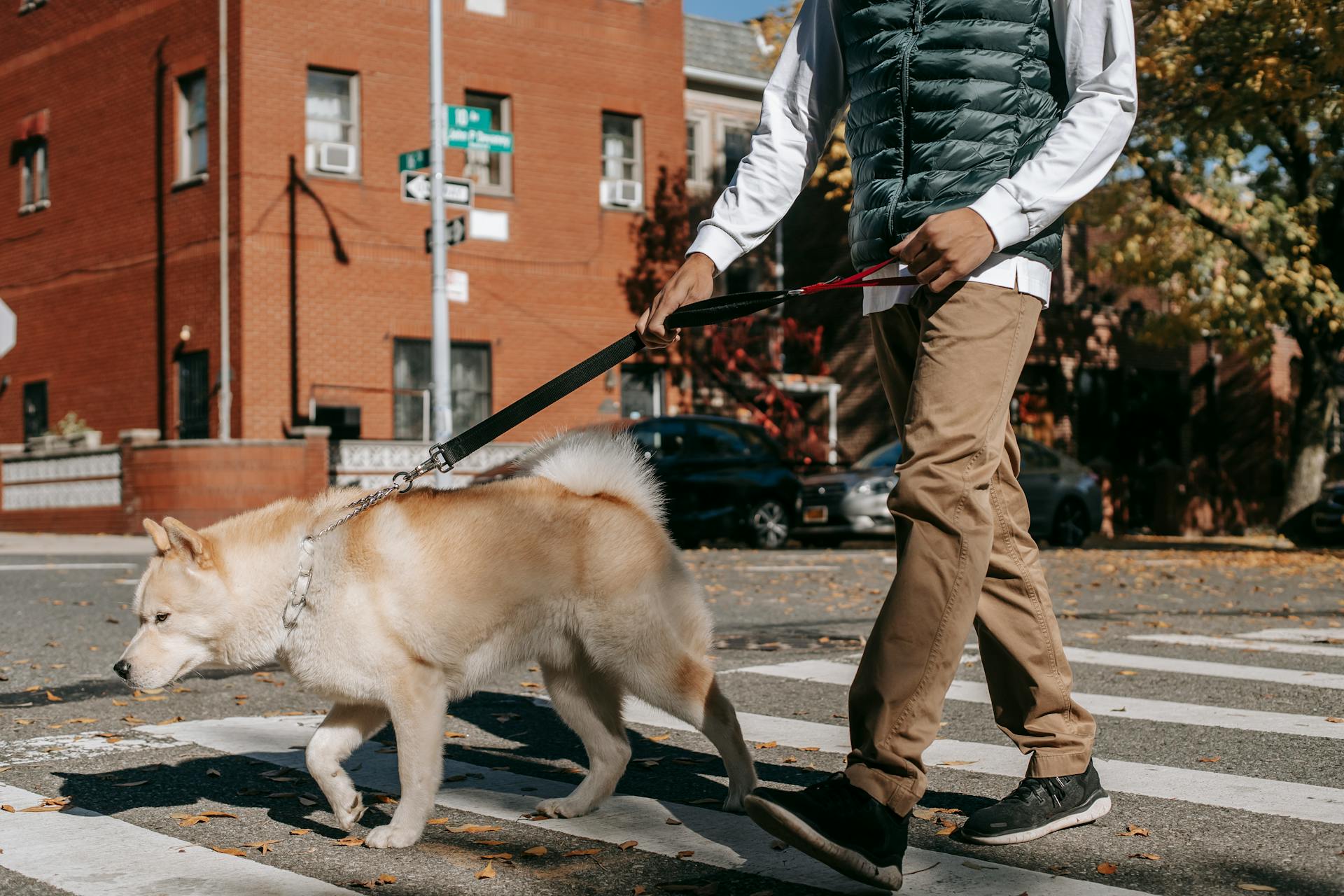
The Siberian Husky is a working dog breed that's been used as sled dogs in Siberia, where they were critical for human survival. They're built for endurance and thrive in cold climates.
The Alaskan Malamute is descended from wild wolves and likes to run in packs. They're very playful and need a lot of outdoor time to stay happy.
The Shiba Inu is smaller than the Akita, but shares Japanese heritage. They've been around since 7000 B.C., making them one of the oldest breeds of hunting dogs in the world.
The Finnish Spitz is a hunting breed from Finland that's known for barking. Its appearance is similar to a fox.
Here are some breeds that share similarities with the American Akita:
- Samoyed
- Siberian Husky
- Alaskan Malamute
- Shiba Inu
- Finnish Spitz
Health and Care
The American Akita's grooming needs are relatively simple, but regular brushing is essential to prevent matting and parasite infestation. Several times a week is sufficient to keep their coat healthy.
Brushing daily during the coat change season will help them get rid of excess hair more easily and reduce scratching. Regular ear cleaning is also crucial to prevent parasite infestation and possible hearing problems.
To keep your American Akita's health in check, regular vaccinations, worming, and mite protection are a must. Regular check-ups with your vet will help identify any potential issues early on.
Health and Lifespan
The American Akita's lifespan is relatively long, ranging from 10-13 years. This is impressive for a larger breed. Regular veterinarian checkups are essential to monitor their health and prevent potential problems.
Autoimmune diseases, hip dysplasia, and anxiety are common health concerns for American Akitas. It's crucial to keep an eye on their diet and arrange regular checkups with your vet.
Akitas typically live between 12 to 15 years, which is a relatively long life for a larger dog. This is a good thing, but it's essential to be aware of the potential health issues that can arise.
Here are some common health problems that can affect American Akitas:
- Autoimmune diseases
- Hip dysplasia
- Anxiety
Regular ear cleaning is essential to prevent parasite infestation and potential hearing problems. It's also crucial to check your Akita regularly for signs of parasite infestation, such as itching, sticky ears and eyes, and injuries.
The Dietary Guide
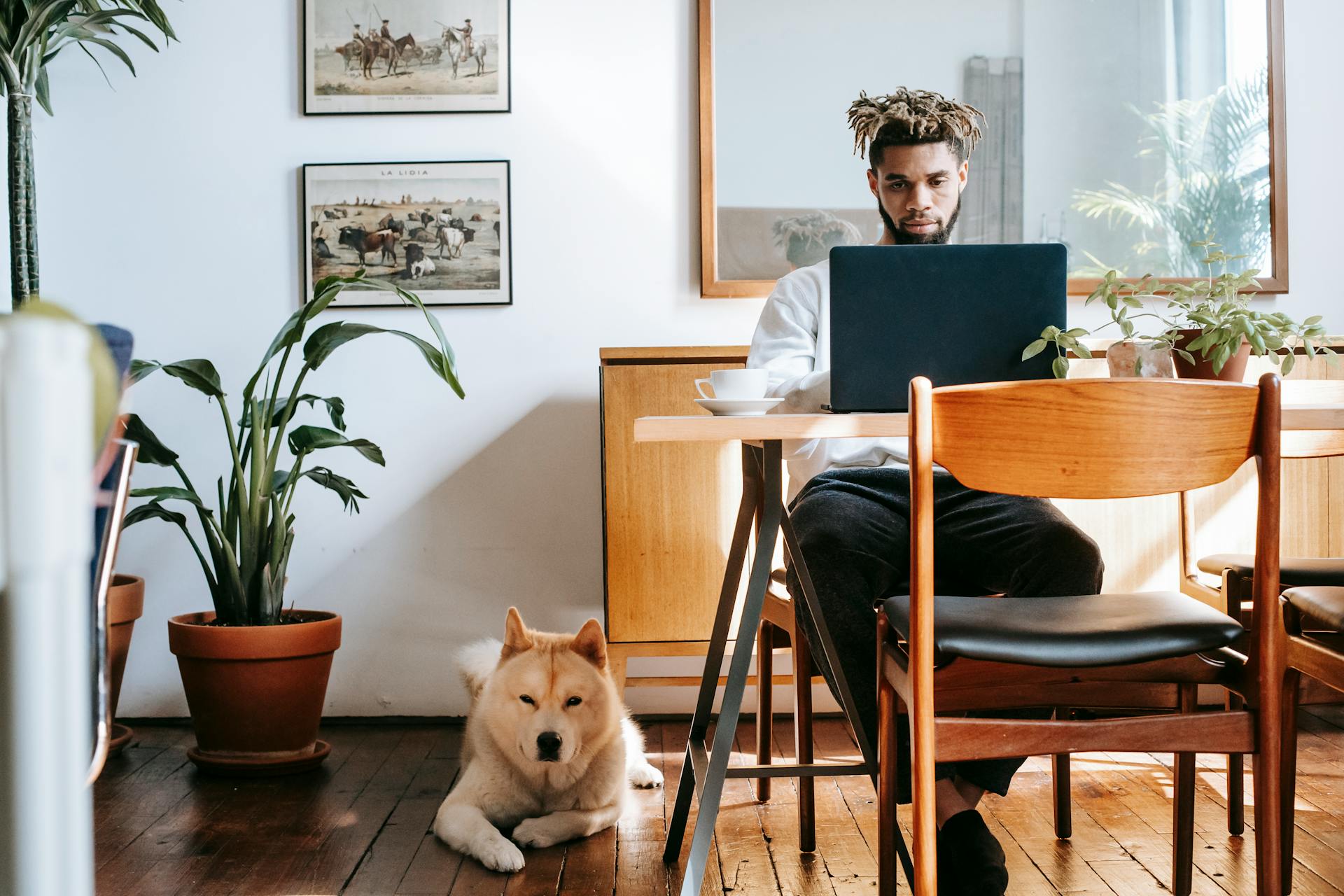
Your American Akita requires a balanced and nutrient-rich diet to maintain its health and vitality. A high-quality protein source, such as chicken, beef, fish, or lamb, is essential for muscle development and tissue repair.
Proteins are the building blocks of your dog's muscle mass, and they need a significant amount to stay healthy. Aim for 1 gram of protein per pound of your dog's body weight daily.
A balanced diet should include healthy fats, which provide a concentrated energy source and are important for healthy skin and a shiny coat. Omega-3 and Omega-6 fatty acids, found in fish and high-quality oils, are particularly beneficial.
Fibers promote good digestion and contribute to intestinal health. Vegetables, fruits, and whole grains are good sources of fiber.
To support your dog's immune system and overall health, a balanced diet should include vitamins and minerals. Supplements can be beneficial but should be administered under a veterinarian's supervision.
Here are some essential nutrients to look for in your dog's food:
- Protein sources like chicken, beef, fish, or lamb
- Healthy fats like Omega-3 and Omega-6 fatty acids
- Fibers from vegetables, fruits, and whole grains
- Vitamins and minerals for immune system support
Leave Pet Alone
Leaving your pet alone can be a challenge, but with the right approach, it's definitely doable. Generally, Akita's cope well with being alone.
Crate training, especially during puppyhood, can be a game-changer in preventing separation anxiety. This helps them get used to solo time from a young age.
Leaving your Akita at home alone is very possible, but it's essential to do so in moderation. They will eagerly await your return.
You can start by introducing them to crate training from a young age, and it's best to begin with short periods of time.
If this caught your attention, see: All about Dogs Dog Training
Origin and History
The American Akita has a rich and multifaceted history, marked by specific breeding practices, controversial use, and their introduction to North America.
The breed is part of the Spitz family and was developed by crossing the original Akita with other breeds such as the English Mastiff, Great Dane, Tosa Inu, and St. Bernard.
The first American Akitas were bred in the 1950s, and they were initially used for bear hunting and dog fighting.
Origins and History
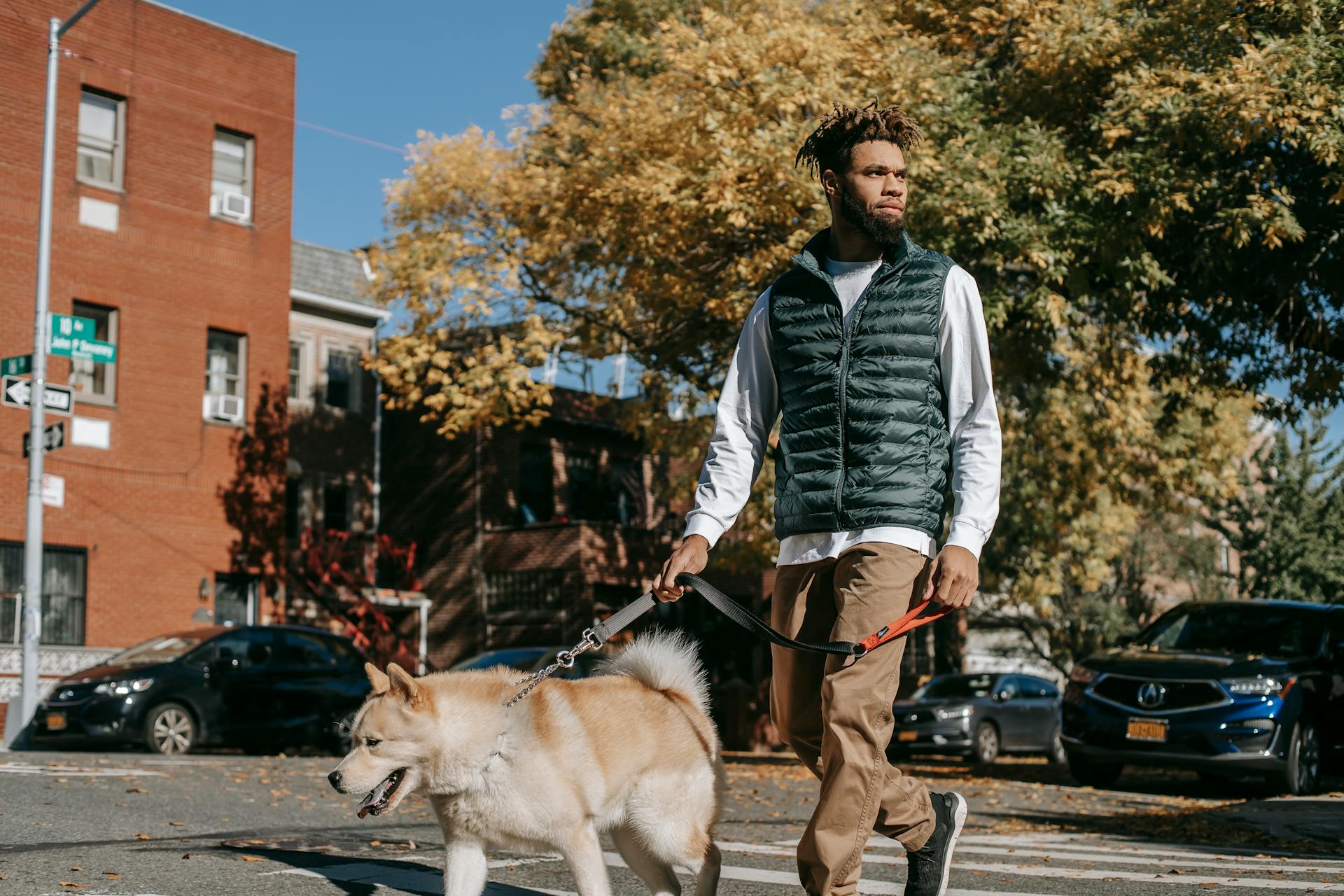
The Akita breed has a rich and fascinating history that spans centuries. It's believed to have originated in the Akita region of Japan as far back as the 1600s.
The first Akita dogs were bred in the Akita region in 1603, specifically for their loyalty and companionship. They were highly valued by the samurai class for their bravery and protective nature.
One of the most interesting facts about the Akita breed is that they were also used for bear hunting and dog fighting in other countries. This is a testament to their strength and agility.
In the 19th century, the Akita breed was crossed with other breeds, including the English Mastiff, Great Dane, and St. Bernard, to create a larger and more powerful dog. This led to the development of the American Akita breed.
The American Akita was first introduced to North America in the early 20th century, where it quickly gained popularity as a loyal companion dog. They were often used as guard dogs and were highly valued for their protective nature.
Despite their tough exterior, Akitas are also known for their gentle and affectionate nature, making them a beloved companion for many families.
Breed Organizations
The Akita breed has a rich history, and understanding the organizations involved can provide valuable insights. The Japanese Kennel Club was instrumental in classifying the American Akita.
The Akita Club of America, the only National Akita Breed Club, is a key organization to learn more about the history of the Akita breeds. It's a great resource for anyone interested in the breed.
The American Kennel Club is another organization that plays a role in the Akita breed. The Japanese Kennel Club submitted a formal proposal to the FCI for a breed split between the Japanese and American Akita dog breeds.
Consider reading: American Akita History
Training and Behavior
Training an American Akita requires patience and persistence, as they can be stubborn and independent. They thrive on positive reinforcement and respond well to gentle and respectful methods.
Socialization is key, especially during puppyhood, to help them become more socialized and less territorial. Introduce them to other animals, children, and strangers in controlled environments, and reward good behavior with treats or soft chews.
Akitas are intelligent and can be trained with the right approach, but harsh methods can make them aggressive. They are naturally protective and territorial, so it's essential to train them to be well-disciplined around strangers and other animals.
Exercise
Akitas are not high-energy dogs, but they still need regular exercise to stay happy and healthy. They enjoy free time in their yard, long walks on cooler days, and hikes with their owners.
Daily exercise is essential to prevent boredom and weight gain. Without it, your Akita might become overweight.
Make sure you have plenty of room for playtime, as Akitas require ample space to run around. Their sturdy size and weight mean they can accidentally knock things over, so double-check your surroundings before letting them play.
Games that appeal to their innate hunting nature are a great way to stimulate their minds. Try teaching your Akita to carry something in their mouth, like a toy or a stick.
As working dogs, Akitas are accustomed to exercising while on the job. They're excellent at guarding and tracking, making them a great companion for hunters.
For more insights, see: Japanese Akita Guard Dog
Behavior and Training
The American Akita is known for its loyalty and protective nature toward its owners, but it can be reserved with strangers. This breed responds best to gentle and respectful methods, and harsh approaches can make it aggressive.
Akitas are intelligent and stubborn, requiring an owner who can be a strict disciplinarian. They need training that is balanced with love and respect, and patience and persistence are essential for obedience training.
Socialization is crucial for Akitas, especially from a young age. Introducing them to other animals, children, and strangers can help them grow into more socialized dogs. Daily walks are a great time to do this.
Akitas are naturally protective and territorial, but with proper training and socialization, they can learn to manage this instinct. They make ideal guard dogs, but they're not yappy dogs and only bark to warn you of incoming strangers and changes in environments.
Positive reinforcement is key when training an Akita. Reacting negatively or treating them harshly during training can result in them lashing out. Akitas respond best to rewards and praise, and they will strike quickly and without any telling behavioral cues.
Akitas are not expressive dogs and may not show their emotional reactions like other breeds. However, they will defend their family and territory if they feel threatened. With proper training and socialization, Akitas can learn to be well-disciplined around strangers.
In single-dog households, Akitas tend to be more aggressive towards other dogs, especially those of the same sex. However, with early socialization and training, Akitas can learn to coexist with other dogs.
See what others are reading: Akita Dog Training
Frequently Asked Questions
How much does American Akita cost?
The cost of an American Akita puppy from a reputable breeder typically ranges from $1,000 to $3,000. This price includes the puppy's health clearances, vaccinations, and initial care.
What are the disadvantages of American Akitas?
American Akitas can be high-maintenance pets due to their excessive shedding, strong prey drive, and potential for aggression, making them unsuitable for inexperienced owners. They also require constant entertainment and socialization to prevent behavioral issues and ensure a happy, healthy relationship.
Is American Akita a good family dog?
American Akitas can be a good fit for families, but it's essential to consider their large size and potential aggression around small children
Are Akita dogs safe?
Generally, Akitas are safe family pets when properly trained and socialized, but their strong instincts and high prey drive require careful consideration and attention from experienced owners
What is the difference between Akita Inu and American Akita?
The main difference between Akita Inu and American Akita is their size, with American Akitas generally being larger and more muscular. Originating from Japan, Akita Inu tends to have a more elegant, fox-like appearance.
Sources
- https://www.hundeo.com/en/dog-breeds/american-akita/
- https://basepaws.com/dog-insider/american-akita-vs-japanese-akita
- https://penelopesbloom.com/pet-breeds/dogs/american-akita/
- https://www.marly-dan.com/en-us/blogs/dog-breeds/american-akita-majestic-loyal-dog/
- https://www.holistapet.com/blogs/dog-breeds/american-akita
Featured Images: pexels.com
